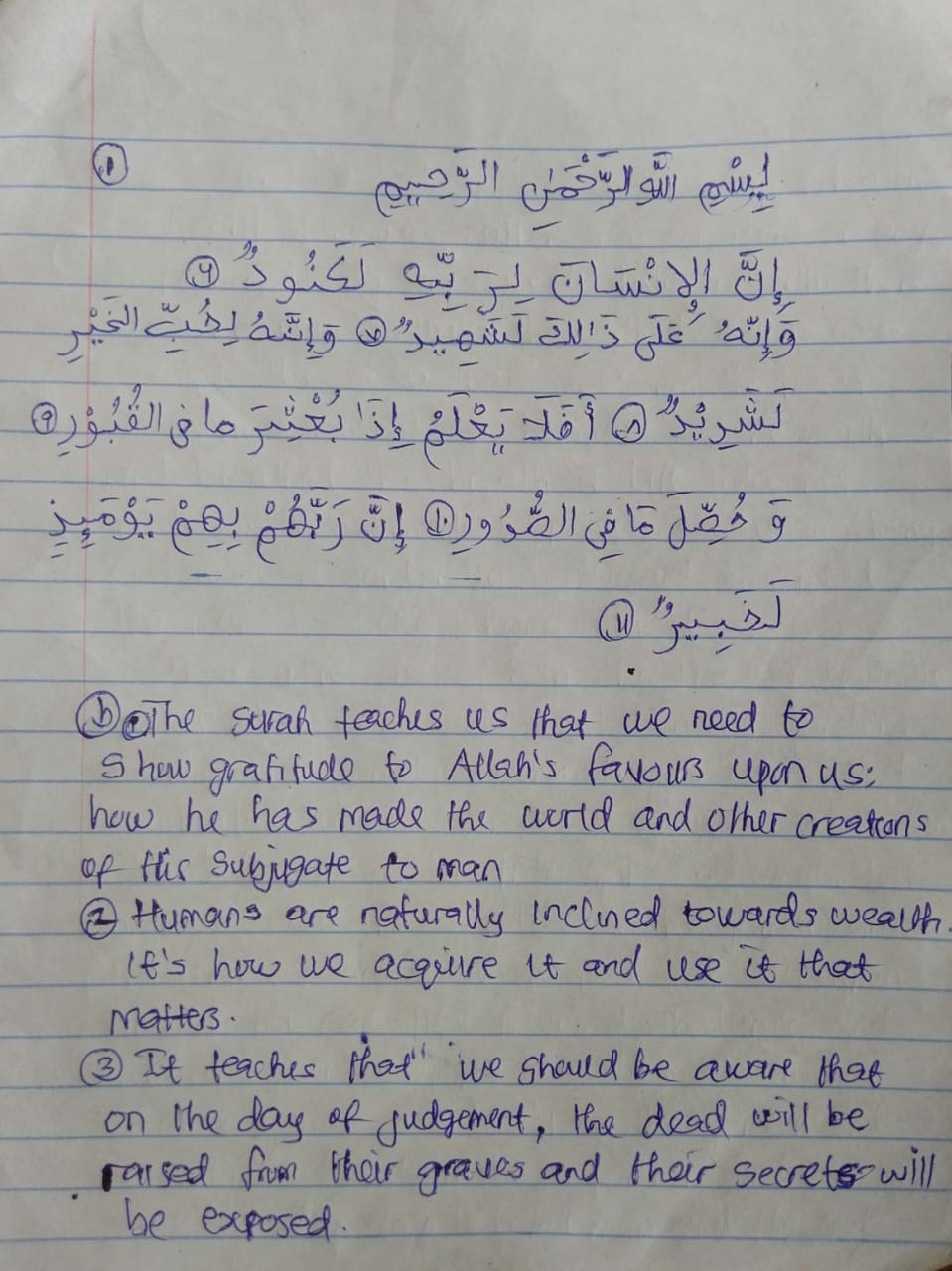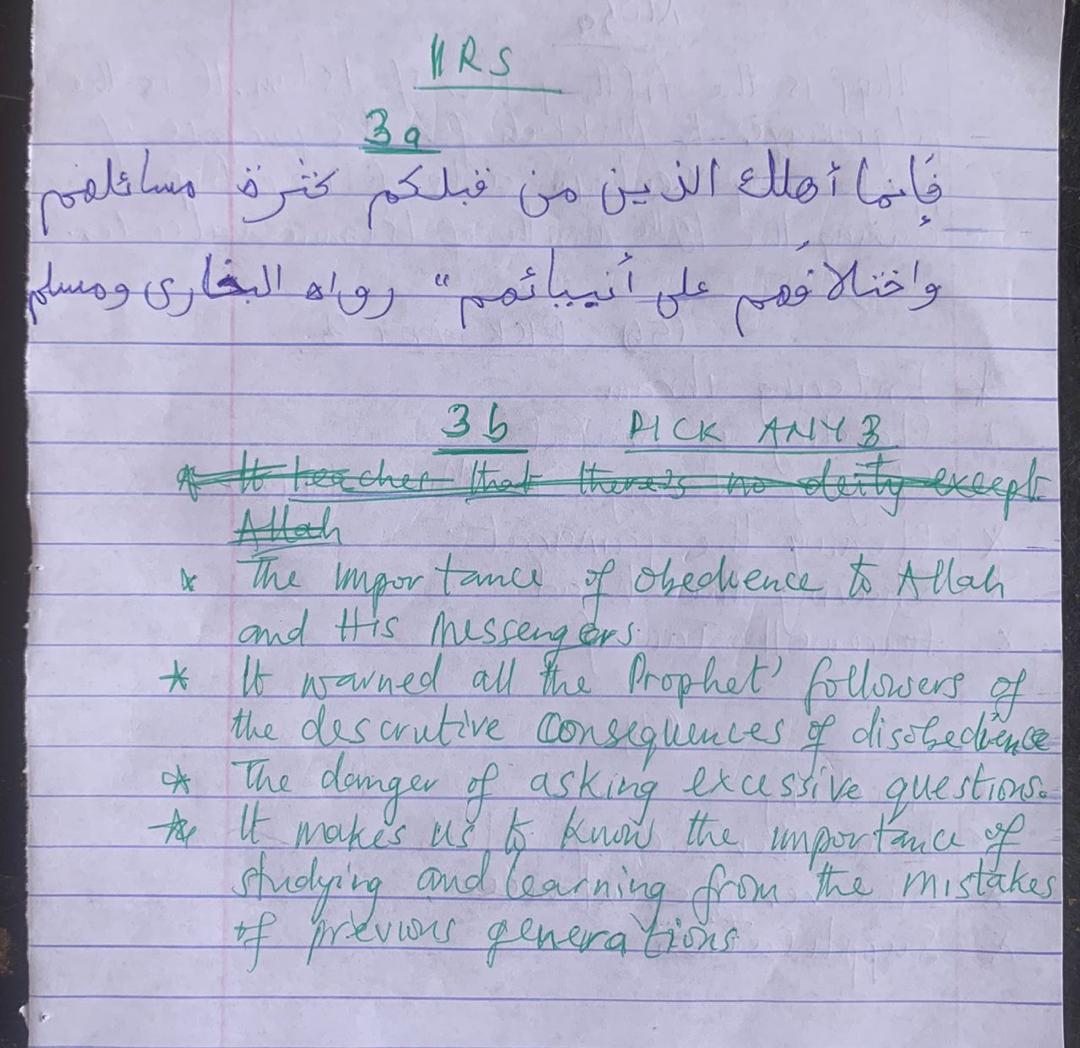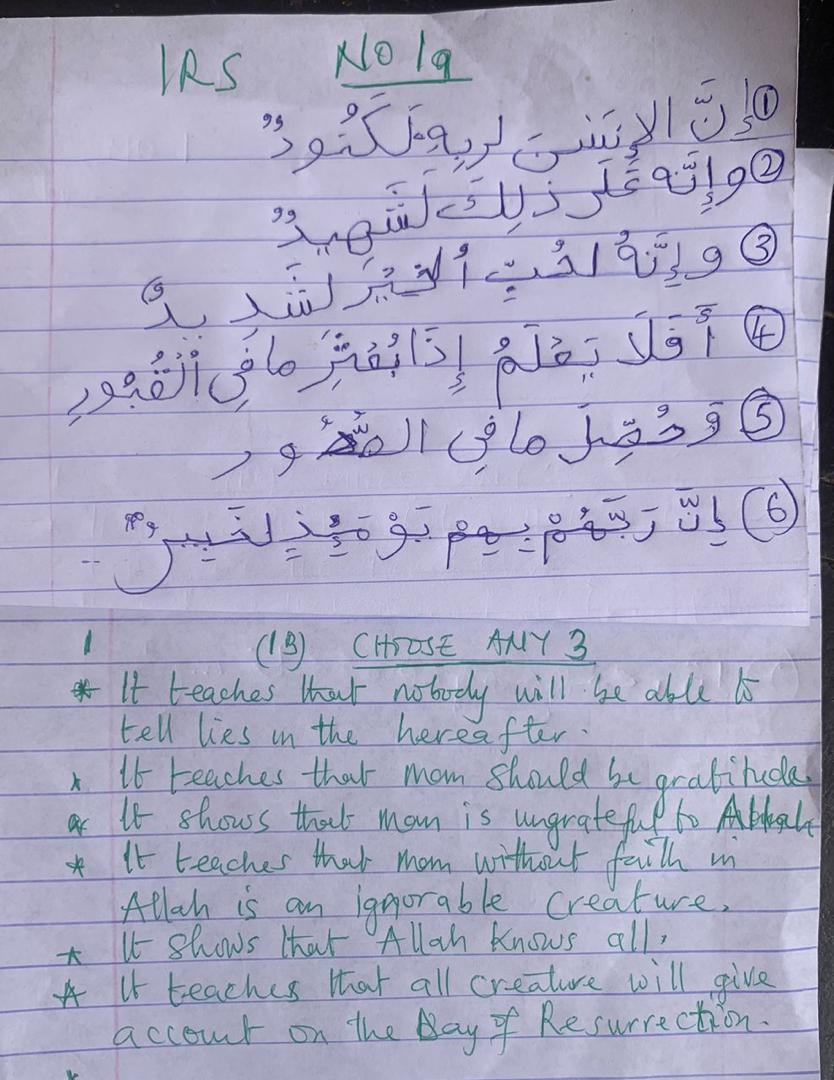NECO GCE 2023 CRS/IRS ANSWERS FREE
NECO GCE IRS & CRS ANSWERS
IRS-OBJ
01-10: EDBCEABABE
11-20: ECCCDBADCA
21-30: EECCEABADE
31-40: ACDBBECECC
41-50: BECCADCDBA
51-60: BADBAEADBA




(5a)
Hajj is a sacred pilgrimage that is required of every Muslim at least once in their lifetime. In other words it is one of the fifth pillars of Islam. Each year, millions of Muslims from across the world travel to and perform Hajj in Makkah.
(5b)
(i)Entering ihram
(ii) Standing in ‘Arafah
(iii)Staying overnight in Mina
(5c)
(i)Remembrance of Allah, especially on the Day of Arafat
(ii)Fasting on the Day of Arafat
(iii)Sincere repentance in Zulhijjah and on the Day of Arafat
===
(4a)
(i)Revelation; The Prophet’s(sallallahu alayhi wa sallam) sayings and actions were primarily based on revelation from Allah and, as such, must be considered a fundamental source of guidance second only to the Qur’an. Allah in the Qur’an said concerning the Prophet.
(ii)Tafseer; The preservation of the Qur’an was not restricted to protecting its wording from change. Were that the case, its meanings could be manipulated according to human desires, while maintaining its wording. However, Allah also protected its essential meanings from change by entrusting the explanation of the meanings of the Qur’an to the prophet himself.
(iii)Laws; One of the primary duties of the prophet was to judge between people in their disputes. Since his judgements were all based on revelation, as stated above, they must be considered a primary source of principles by which judgements are carried out in an Islamic state.
(4b)
(i)The Hadith is a collection of sayings and actions of Prophet Muhammad, while the Quran is the holy book of Islam.
(ii)The Hadith provides further guidance and explanations for the teachings of the Quran.
(iii)They complement each other in understanding and practicing Islam.
(8a)
Abdullah bn Fodio, also known as Shaykh Usman dan Fodio, was a prominent Islamic scholar, reformer, and leader in West Africa during the 18th and 19th centuries. Hewas born in 1754 in Gobir, present-day Nigeria, and belonged to the Fulani ethnic group. He received a comprehensive Islamic education from an early age and became well-versed in various Islamic sciences, including theology, jurisprudence, and philosophy.
(8b)
(i) Islamic Scholarship: Abdullahi ibn Fodio was known for his deep knowledge of Islamic sciences.
(ii) Islamic Reformation: Abdullahi ibn Fodio aimed to reform the practice of Islam in West Africa, focusing on eliminating what he considered to be deviations and heresies.
(iii) Jihad and Political Leadership: With a vision to establish an Islamic state based on justice and equity, Abdullahi ibn Fodio led a successful jihad (holy war) against the Hausa rulers in northern Nigeria.
IRS THEORY & OBJ LOADING…
IRS typing…..
NECO GCE 2023 CRS
NECO CRS -OBJ
01-10: BEBBACCBCD
11-20: EDDEBECBAE
21-30: BCBAEDEDED
31-40: CACEAAEDBE
41-50: DCBBBEACBC
51-60: EEBADDCBBE
CRS THEORY ANSWERS
(1a)
In the second creation story, as contained in Genesis chapter 2, the narrative begins by stating that after God had created the heavens and the earth, He formed man from the dust of the ground and breathed into his nostrils the breath of life, making him a living being. God then planted a garden in Eden and placed the man in it, giving him the responsibility to work it and take care of it.
God also commanded the man, stating that he could eat from any tree in the garden except for the tree of the knowledge of good and evil. If he were to eat from that tree, he would surely die. God then noticed that it was not good for the man to be alone, so He decided to make a helper suitable for him.
God brought all the animals to the man, and he named them all, but none of them were found to be a suitable helper. So, God caused the man to fall into a deep sleep, and while he was asleep, He took one of his ribs and made it into a woman. When the man woke up and saw the woman, he recognized her as his own flesh and bone, and they became one flesh.
(1b)
(PICK ANY THREE)
(i) Stewards of Creation
(ii) Creation of Social Relationships
(iii) Naming and Naming Responsibility
(iv) Responsibility to Obey God’s Command
(iv) The Gift of Life
(vi) Unity and Companionship
*NUMBER TWO*
(2a)
The event that led to the reconciliation of David and Abner was the death of Abner’s cousin, Asahel, during a battle between David’s forces and Abner’s forces. Asahel was chasing Abner to avenge the death of his brothers, but Abner warned him to turn back multiple times. When Asahel didn’t listen, Abner reluctantly killed him in self-defense. This event created an opportunity for reconciliation between David and Abner because it demonstrated a willingness on Abner’s part to avoid unnecessary bloodshed and a recognition of the tragic consequences of the ongoing conflict.
(2b)
(PICK ANY THREE)
(i) Forgiveness can lead to peace: David was able to forgive Abner for killing his cousin, and in doing so, he opened the door to reconciliation and a potential end to the conflict.
(ii) Communication is essential: Abner and David took the opportunity to engage in open and honest communication after the death of Asahel. This allowed them to understand each other’s perspectives and find common ground.
(iii) Conflict is not always personal: Abner and David’s initial rivalry was rooted in the political landscape rather than personal animosity. Their reconciliation demonstrated that it is possible to separate personal feelings from political differences.
(iv) The value of a mediator: Joab, David’s commander, played a critical role in facilitating the reconciliation between David and Abner. Having a neutral third party can help bridge the gap and facilitate understanding between conflicting parties.
(v) Tragedy can bring people together: The death of Asahel created a shared experience of loss for David and Abner, which ultimately led to their reconciliation. Sometimes, it takes a tragic event to make people realize the unnecessary cost of conflict.
(vi) Reconciliation requires compromise: Both David and Abner had to make compromises and let go of their previous grievances in order to reconcile. This emphasizes the importance of finding common ground and being willing to let go of past hurts in the pursuit of peace.
CRS
(3a)
Prophet Hosea’s marital experience is a significant aspect of his prophetic ministry. According to the Bible, Hosea was instructed by God to marry a woman named Gomer, who later became unfaithful to him, symbolizing the unfaithfulness of Israel towards God.
Hosea’s marriage to Gomer represented the relationship between God and Israel, with Hosea embodying God’s faithfulness despite Israel’s spiritual adultery. Despite Gomer’s infidelity, Hosea continued to love her and even redeemed her from a situation of slavery, reflecting God’s unconditional love and forgiveness for Israel.
Through this personal experience, Hosea conveyed God’s message of love, mercy, and the consequences of unfaithfulness. His marital life served as a powerful illustration of God’s enduring love for His people, despite their waywardness and unfaithfulness.
(3b)
(i) Covenant and Commitment: Marriage symbolizes God’s covenant with humanity. Just as a marriage is a covenant between two individuals to love, cherish, and remain faithful to each other, God’s commitment to humanity is everlasting and unwavering, demonstrating His unending love and faithfulness.
(ii) Selfless Sacrifice: The sacrificial love between spouses mirrors God’s sacrificial love for humanity. In marriage, partners are called to love each other unconditionally, putting their partner’s needs above their own. This selfless love is akin to the sacrificial love shown by Jesus Christ for humanity.
(iii) Unity and Oneness: The union of two individuals into one entity in marriage reflects the unity found in the relationship between God and humanity. Just as marriage signifies the unity of two distinct individuals becoming one, God desires a close and unified relationship with humanity, emphasizing the concept of oneness and togetherness.
(4a)
In the Bible, Matthew, also known as Levi, was a tax collector. Tax collectors were generally despised by the Jewish people because they worked for the Roman Empire and often collected more money than required, pocketing the extra for themselves. One day, Jesus saw Matthew sitting at the tax collector’s booth and said to him, “Follow me.” Matthew immediately got up and followed Jesus.
Afterwards, Matthew invited Jesus and his disciples to his house for a meal. Many other tax collectors and sinners also joined them. This caused the Pharisees, who were religious leaders, to criticize Jesus for associating with such people. Jesus responded by saying, “It is not the healthy who need a doctor, but the sick. I have not come to call the righteous, but sinners.”
(4b)
(i) Acceptance and Inclusion
(ii) Transformation and Redemption
(iii) Prioritizing Compassion over Judgment
(7a)
Jesus described Himself as:
(i) The Living Water: Jesus told the woman that He could give her living water, which would become in her a spring of water welling up to eternal life. This was a metaphorical way of expressing spiritual renewal and eternal life through faith in Him.
(ii) The Messiah (Christ): Jesus acknowledged to the Samaritan woman that He was the Messiah, the one whom the Samaritans and Jews were both expecting. This revelation demonstrated Jesus’ identity as the promised Savior.
(iii) The One Who Knows All About Her: Jesus revealed details about the woman’s personal life, indicating that He had a deep knowledge and understanding of her. This demonstrated Jesus’ divine insight and awareness.
(7b)
(i) Recognition of Christ as the Messiah
(ii) Living Water and Spiritual Nourishment
(iii) Inclusive Nature of Salvation
INVITE UR FRNDS NOW!!

Leave a Reply